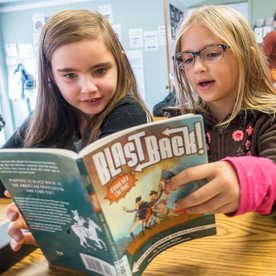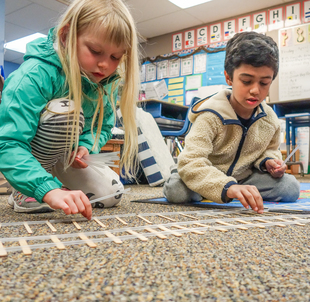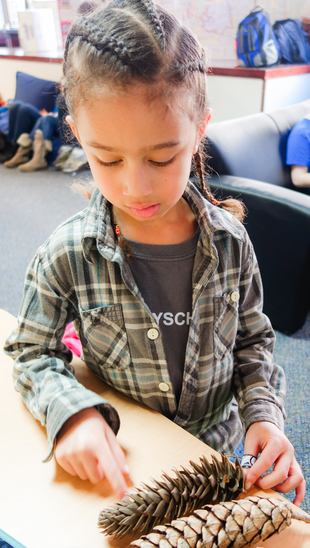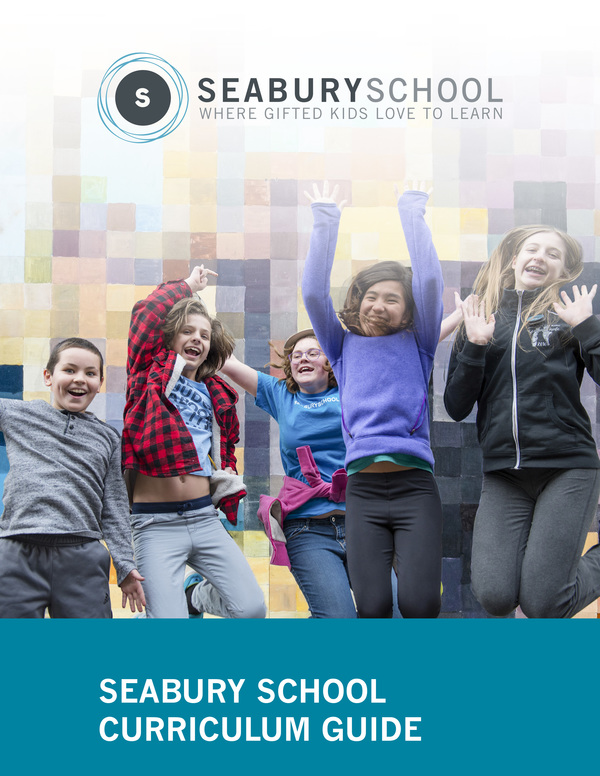
A four-year learning adventure
Students in the primary grades at Seabury School have the opportunity to participate in a four-year educational adventure with hands-on experiential learning opportunities at every turn. With broad central concepts, integrated multidisciplinary units, and an emphasis on STEAM at the core of the curriculum, learning is an engaging, joyful experience for Seabury's first through fourth grade students. It's evident when you walk into the classrooms. There might be a castle, a Viking ship, or transcontinental railroad tracks spanning the carpet. Students could be writing in Cuneiform like the ancient Sumerians of Mesopotamia. They could be flash-freezing a structure of carbon, glucose, water and soil to understand the composition of a comet. Frequently, students aren't in the classroom. They might be in the MakerSpace, in the pre-k room mentoring younger students, or off on one of the field excursions that are a prime feature of a Seabury education.
Inquiry-based learning & differentiation

Four broad concepts
Year One: Innovation
Over the course of this year, students learn how societies grow and change through scientific and mathematical advancement. Content includes ancient civilizations, world geography, changing political borders and the sciences of archaeology, astronomy and physics. Curriculum is integrated with a focus on STEAM. Students take a hands-on approach to learning just as people in ancient societies did. As the culminating project, students will create their own cultures and participate in an archeological dig.Year Two: Quest
Year Three: Treasure
Year Four: Transitions
This year the students' inquiry, investigation and discovery dives deep into the broad question of how transitions relate to human history. Evaluation without bias is a focus as they study the American Revolutionary War, Westward Expansion and the Civil War. They will examine how changes in history affected culture and society. Hands-on science topics woven through the units include technology, engineering, machinery and electricity. Students develop an understanding of the diverse group of people who made important contributions in these areas. In doing so, they study how transitions affect people and society.
- Over 4 years, each primary student ...
- Eliza and her Shadow
- Overheard in the primary grades
 Writes research reports
Writes research reports- Polishes typing skills
- Collaborates on projects
- Knows and uses the Scientific Method
- Reads and makes maps
- Compares and contrasts literary elements
- Understands how to use the internet safely
- Learns to read the Periodic Table of the Elements
- Understands the power of mindfulness
- Mentors younger children
- Will develop a growth mindset
- Will learn to use library databases for research
- Builds simple machines
- Participates in an archeological dig
- Writes research papers
- Creates illustrated timelines of historical events
- Builds simple circuits and electrical machines
- Builds on technology skills, including coding, Word, PowerPoint, Canva, and Prezi
- Completes research focusing on diversity in the scientific community
- Recognizes the relative measurements of circles and angles using planetary axis
- Presents at gatherings of larger segments of the school community
- Learns to ask a great question
- Develops classification, Venn diagram and graphing skills
- Creates an invention in the MakerSpace
- Creates a life-sized Vitruvian person
- Studies Fibonacci's Golden Ratio
- Participates in Operation Egg Drop
- Learns from medical professionals about the workings of the human body
- Helps build a castle, a ship and a covered wagon
- Is exposed to literature from different genres, both fiction and nonfiction
- Learns about Earth's biomes, geology, botany, animal life cycles and taxonomy
- And so much more!
We know our kids are exceptional. They make us say "wow" every day. Often, they make us say "WOW!!" with capital letters and exclamation points. This story written by a first grader during one literacy period using Story Cubes as a prompt is such an example. (It's transcribed as it was written in pencil, no teacher editing.)
Eliza and her Shadow
Once there was a girl who was scared of her shadow. Her name was Eliza. When she saw her shadow, her lip trembled like a truck on a turtle's shell. One day Eliza rolled an alphabet dice. She said that whatever letter she landed on wheather it be A or Z, it would be her favorite letter. She landed on L. And then she thought of a word. Lake, she thought. I'll run to the lake. When she got there, there was something that had never been there before. A broken bumpy bridge. I'll cross it, Eliza thought. After she crossed it, she saw the shadow of a goldfish. She screamed. She yelled. There was nobody to help her. It's just a shadow, she thought. She said, "Mr. Goldfish, may I help you?" He said, "take me to the end of the rainbow behind me." "Alright," said Eliza. "This way." When they got to the end of the rainbow, there was a gold greedy goblin mask lying on the ground. There was a clock attached to the end of the rainbow. It said 2:00. "Oh no!" The goldfish cried. "It's almost time!" "What time?" Eliza asked. "At 2:15, the golden mask will vanish!" he said. "Go to your home in this plane!" At that moment, she woke up, and realized it was all a dream.
THE END
Just like doting parents, we try to jot down the funny, insightful, and sometimes jaw-dropping things our kids say. You can find some scattered through our website. For your enjoyment, here are a few more direct quotes from our first through fourth graders.
- Third grader: "If we can grow thyme, then we can grow 4 o'clock."
- A first grader tasked with choosing from a sheet of cupcake stickers: "This is my flavorite."
- First grader: "Duct tape has an attitude."
- Her teacher asks a first grader if she can play a lot of songs on her new ukelele. The answer: "I indubitably can!"
- Third grader: "I'm not saying it's bad that you're German. I'm not a country-ist."
- Second grade boy: "I wish there was a book called Hermoine Granger, not Harry Potter, just Hermoine Granger."
- A third grader walks out, leaving the classroom door wide open: "I just can't door today."
- Second grade boy: "Boys can do anything girls can do!"
- Second grader during a LEGO challenge: "It's a simulator, a flying simulator, just a normal, average flying simulator."
- Fourth grade girl: "What is it with boys and sound effects?"
Learn more in Seabury's Curriculum Guide

